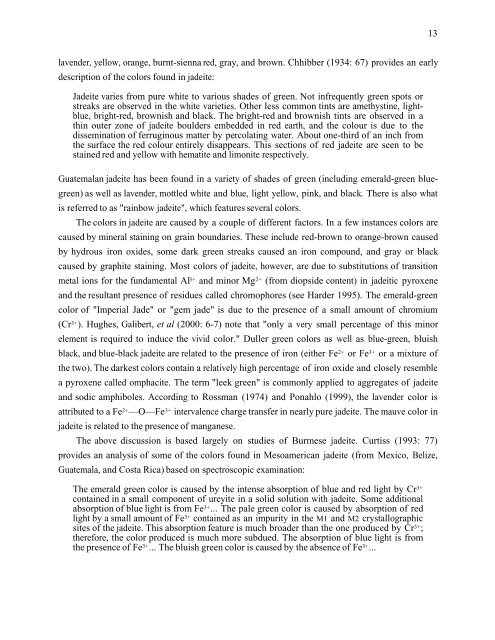JADEITE - Canadian Institute of Gemmology
JADEITE - Canadian Institute of Gemmology
JADEITE - Canadian Institute of Gemmology
You also want an ePaper? Increase the reach of your titles
YUMPU automatically turns print PDFs into web optimized ePapers that Google loves.
lavender, yellow, orange, burnt-sienna red, gray, and brown. Chhibber (1934: 67) provides an early<br />
description <strong>of</strong> the colors found in jadeite:<br />
Jadeite varies from pure white to various shades <strong>of</strong> green. Not infrequently green spots or<br />
streaks are observed in the white varieties. Other less common tints are amethystine, lightblue,<br />
bright-red, brownish and black. The bright-red and brownish tints are observed in a<br />
thin outer zone <strong>of</strong> jadeite boulders embedded in red earth, and the colour is due to the<br />
dissemination <strong>of</strong> ferruginous matter by percolating water. About one-third <strong>of</strong> an inch from<br />
the surface the red colour entirely disappears. This sections <strong>of</strong> red jadeite are seen to be<br />
stained red and yellow with hematite and limonite respectively.<br />
Guatemalan jadeite has been found in a variety <strong>of</strong> shades <strong>of</strong> green (including emerald-green blue-<br />
green) as well as lavender, mottled white and blue, light yellow, pink, and black. There is also what<br />
is referred to as "rainbow jadeite", which features several colors.<br />
The colors in jadeite are caused by a couple <strong>of</strong> different factors. In a few instances colors are<br />
caused by mineral staining on grain boundaries. These include red-brown to orange-brown caused<br />
by hydrous iron oxides, some dark green streaks caused an iron compound, and gray or black<br />
caused by graphite staining. Most colors <strong>of</strong> jadeite, however, are due to substitutions <strong>of</strong> transition<br />
metal ions for the fundamental Al 3+ and minor Mg 2+ (from diopside content) in jadeitic pyroxene<br />
and the resultant presence <strong>of</strong> residues called chromophores (see Harder 1995). The emerald-green<br />
color <strong>of</strong> "Imperial Jade" or "gem jade" is due to the presence <strong>of</strong> a small amount <strong>of</strong> chromium<br />
(Cr 3+ ). Hughes, Galibert, et al (2000: 6-7) note that "only a very small percentage <strong>of</strong> this minor<br />
element is required to induce the vivid color." Duller green colors as well as blue-green, bluish<br />
black, and blue-black jadeite are related to the presence <strong>of</strong> iron (either Fe 2+ or Fe 3+ or a mixture <strong>of</strong><br />
the two). The darkest colors contain a relatively high percentage <strong>of</strong> iron oxide and closely resemble<br />
a pyroxene called omphacite. The term "leek green" is commonly applied to aggregates <strong>of</strong> jadeite<br />
and sodic amphiboles. According to Rossman (1974) and Ponahlo (1999), the lavender color is<br />
attributed to a Fe 2+ —O—Fe 3+ intervalence charge transfer in nearly pure jadeite. The mauve color in<br />
jadeite is related to the presence <strong>of</strong> manganese.<br />
The above discussion is based largely on studies <strong>of</strong> Burmese jadeite. Curtiss (1993: 77)<br />
provides an analysis <strong>of</strong> some <strong>of</strong> the colors found in Mesoamerican jadeite (from Mexico, Belize,<br />
Guatemala, and Costa Rica) based on spectroscopic examination:<br />
The emerald green color is caused by the intense absorption <strong>of</strong> blue and red light by Cr 3+<br />
contained in a small component <strong>of</strong> ureyite in a solid solution with jadeite. Some additional<br />
absorption <strong>of</strong> blue light is from Fe 3+ ... The pale green color is caused by absorption <strong>of</strong> red<br />
light by a small amount <strong>of</strong> Fe 3+ contained as an impurity in the M1 and M2 crystallographic<br />
sites <strong>of</strong> the jadeite. This absorption feature is much broader than the one produced by Cr 3+ ;<br />
therefore, the color produced is much more subdued. The absorption <strong>of</strong> blue light is from<br />
the presence <strong>of</strong> Fe 3+ ... The bluish green color is caused by the absence <strong>of</strong> Fe 3+ ...<br />
13









